1880 to 1900
When we think of industry in the Longwarry District it is natural to regard Dairy as the foundations on which we were built. Of course dairying and the coming of the Longwarry and District Dairyman’s Cooperative, which was first begun in 1919 and finally established in 1921, were major contributors to early prosperity.
However it was the need for timber and the coming of the railway that were the first factors that opened up the District, Longwarry was the hub of that industry and has received little recognition as one of the major timber towns.
The 1850s gold discoveries in Victoria, in Beechworth, Ballarat and Bendigo sparked gold rushes similar to the California Gold Rush. At its peak some two tonnes of gold per week flowed into the Treasury Building in Melbourne.
The gold exported to Britain paid all of Victoria’s foreign debts and helped lay the foundation of wealth and enormous commercial expansion in the latter half of the century.
As people flocked to Victoria from all over the world the population and wealth grew rapidly. Melbourne was a major boomtown during the gold rush. The city became the centre of the colony with rail networks radiating to the regional towns and ports.
The need for construction material for housing and commercial properties was boundless and the tall stands of timber relatively close to Melbourne’s east, with a new rail link, were just what the Colony needed in the second half of the Century.
In a geological sense it was the Bunyip River, and its tributaries that created fertile valleys which made the timber so valuable. The rich soils and moderate climate over centuries produced huge forests of Mountain Ash and Stringy Bark trees.
These huge stands of timber meant that District timber remained a major source of timber for more than 50 years and the network of tramways that brought 486,000 tons of timber to the railhead, finally closed down in 1933 meaning that our District out lived many other timber producing areas.
The railway came to what we know as Longwarry in the late 1870’s and a railway siding was set out to the north side of what is now called Bennett Street, across from the intersection of McCrae Street, on land close to where the factory now stands.
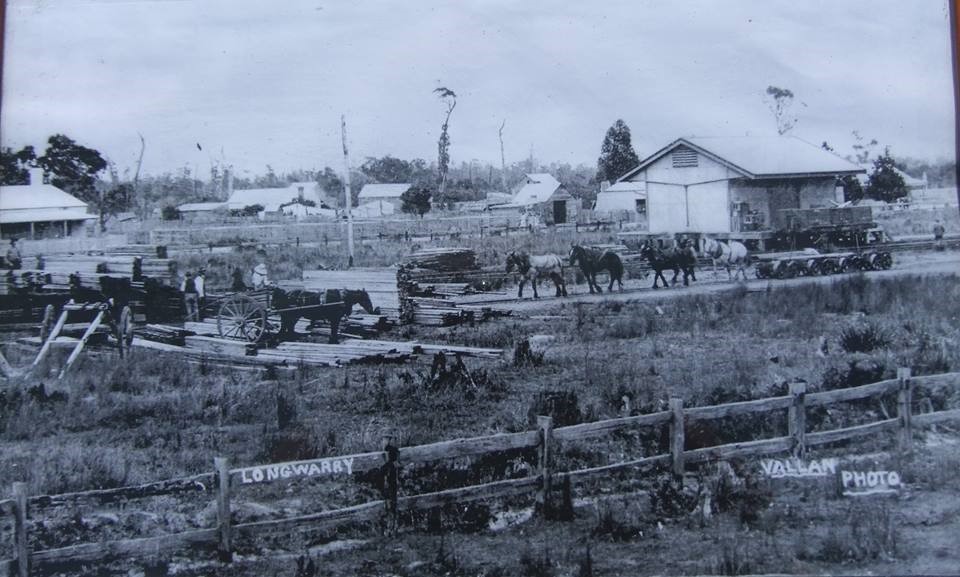
The yards at Longwarry if you look closely you can see the tram wheels on the wagon center right.
Photo Courtesy M.J. McCarthy Collection
This siding was called Fraser Siding after Donald Fraser who was without doubt the biggest and one of the earliest saw millers in the area having established a mill around 1881 what is now the site of The Longwarry Union Church at the Corner of Witton Street and Drouin Road.
Timber from around the district to the north was felled and brought to the mill by teams of horses initially with wagons travelling on wooden tram railways.
The sawn timber was then taken from this mill to the siding that bore his name by horse and cart, crossing the eastern end of Mackie Street, to be loaded onto trains for use in the growing town of Melbourne.
Also located at the siding were cattle holding yards for a property about 10 miles or 15kms to the south of the town. This pastoral run was called “Longwarre” (We believe this may have been the original spelling) and obviously from where the town drew its name.
Another saw miller who would closely rival Fraser in terms of size of operation and influence, particularly a few years on, was W.H.Collins.
These two saw millers were arguably the biggest players in the period 1880 to 1900. Whilst not rivals in a business sense as all saw millers were granted leases over the timber they could take. Therefore they were not in competition for logs. They even shared (at a price) parts of the infrastructure to bring logs into the rail yards at Longwarry. However they both had great pride in their work and were competitive in developing their holdings as well as the speed and amount of timber they could get out of the great forests.
Donald Fraser
Donald Fraser – Born June 26th. 1789 in Williamstown, Glengarry Canada – Died August 6th. 1888.
There is little if any argument that Donald Fraser was the first saw mill and tramway owner in the District although he did start out first of all when he set up a mill in Drouin
He had previously operated mills in and around Stawell in central Victoria, providing timber for the gold fields. But ever looking to improve his business, he was attracted to the huge resources of timber to the east of Melbourne, beside the recently opened rail line. However he often ran into trouble with the Buln Buln Shire Council over the dragging of logs along the road to his mill and in fairness to the Council this was not doing the unsealed roads much good, especially in winter. So after another altercation with the powers that be in 1881, Fraser carried out his threat and moved his operations about 8 kilometres west to an unnamed railway siding only recently completed.
This siding later became known as Fraser Siding and The Longwarry Sawmill Company was established. All logging in the bush and loading of timber was generally done by contract workers. There were few in the industry that held permanent employment which, was reserved for the highly skilled sawyers and engine men.
Fraser then set about establishing a second Mill at the intersection of Labertouche and Gipsy Creek about 14 kilometres north of Longwarry.
Also operating in the Parish of Jindivick were John and Alfred Trinca. They were formerly operating out of Warragul.
Both operations sought to establish a tramway to the rail siding in Longwarry and it was decided that Fraser would build on his small tramway that already existed, taking it to the Tarago River some 4 kilometres in distance. The Trincas would connect this with 10 kilometre of tramway to their mill.
The tramway was completed in 1882, but by 1883 the Trincas sold out of their mill to a group of business men, one of whom was none other than Donald Fraser.
The tram rails are described as being made of hardwood and then fixed onto sleepers at intervals of about 1 metre. Horse drawn wagons with wheels to fit the rails would then carry the timber from the bush mills back to the railway siding in what became Longwarry.
The Locomotive,
Ever the entrepreneur and looking for ways to increase his productivity Fraser was not afraid to seek new partners and obtain finance to expand his lease holdings of timber, as evidenced by his stake in the Trinca mill on Labertouche Creek.
He was also in the forefront of innovation when he commissioned a Melbourne firm to build him a steam engine which he unveiled to the residents of Longwarry in 1886 on a cold wet Saturday afternoon in June. When many were looking to the local football for entertainment, it was the whistle of a small locomotive with a vertical boiler that drew an enthusiastic crowd.
Fraser was always looking for ways to improve productivity and profits. The cost of chaff to feed the horses that pulled the timber into Longwarry along the tramways, coupled with the time taken were drawbacks to profitability. It is reported that the engine was restricted to a top speed of 4 miles per hour (about 6.5kph) because of the standard of the wooden tram rails that it ran on. The engine would travel to Labertouche Creek in the morning to collect the felled timber, and then made an afternoon trip to the Gipsy Creek Mill in the afternoon.
Fraser, now in his early 50’s, had begun to suffer with his health and he handed over the reins of the Company to a manager James McCoombe.
Donald Fraser died in a Melbourne Hospital on August 26th.1888 aged 55 after 35 years in the Colony. Wife Mary took over operations of the Company in partnership with her brother in law Alexander Mackay. Manager McCoombe was dismissed, and the Gipsy Creek Mill, which as a result of a down turn in demand had not operated for several months, was sold to a former employee W.H.Collins.
Subsequently Mary Fraser died just one year later and as the depression of the 1890’s began to bite The Longwarry Sawmill Company was declared bankrupt on August 25th. 1893.
The Company continued trading until 1894 to repay as many creditors as possible, many of them business operators in Longwarry and James Jeffers, a shop keeper in the town, was appointed trustee.
The one asset that was of any value was the tramway heading north out of the town, servicing the bush mills and this continued to operate with W.H.Collins using it until he fell out with Jeffers, the administrator of the Fraser estate, in 1894.
However this was not the end of the financial wrangling around the Fraser holdings and W.H.Collins, as you will see later in this story.
W.H.Collins
Died December 6th. 1906
Originally a carpenter from the Macedon District in Victoria, William Henry (Harry) Collins arrived in Longwarry in 1882, and took up a job as a tram driver with the Trinca brothers at the Labertouche Creek mill.
An interesting character, one might say even a colourful character, it is clear from reports that he was a demanding, even belligerent man. Records and local newspaper reports show that he was not unknown in the Warragul and Drouin Courts with allegations ranging from wilful damage of others property to assault. It was Collins’ view that he was only extracting summary justice for ills that had been done to him.
Collins lived at the mill in a small 4 room cottage with his family until 1887 when he purchased the Gipsy Creek mill from Mackay and Donald Fraser, moving it to Robinson Creek, 14 kilometres North of Longwarry.
This meant that Collins no longer had access to a tram line to take his timber to a rail siding, and he had to set about getting leases and permits to construct one.
A line was commenced in 1889, but it was not an easy task when competitors were sometimes obstinate, refusing access across their land. No doubt Collins’ belligerent attitude did not help much.
This tramway used part of the already established Fraser line as far as the Tarago River near where the current bridge across the Tarago is located, and from here the Collins’ line branched off north to the Robinsons Creek mill site.
The section of tram line from the Tarago into Longwarry that was owned by Donald Fraser attracted a fee for Collins to use at the rate of 1shilling and 9 pence per 100 super feet of timber, later reduced to 6 pence. It was this arrangement that eventually wound up in the courts again.
After the bankruptcy of the Longwarry Saw Mill Company the tramline remained operating. It was a source of income enabling the estate administrator James Jeffers to repay creditors of the failed company.
Collins refused to pay rental for some reason that we are unable to determine, however Jeffers, who was not overly fond of Collins anyway, took him to court, not once but three more times. Collins also faced court charges of assault and destruction of property in his time as a district sawmiller.
By way of an example of one such appearance, the following is an extract from:
Warragul Guardian and West Gippsland Advertiser (Warragul, Vic. : 1894), Tuesday 28 August 1894 LONGWARRY ACTION. —An interesting action was tried in the Warragul County Court on Friday last, before His Honor, Judge Casey, in which Mr. Jas. Jeffers, of Longwarry, the trustee of the insolvent estate of the executors of Mary Fraser, deceased, and A. C. Mackay, was plaintiff, and Mr. W. H. Collins, of Longwarry, saw miller, was defendant. The claim was for the recovery of £161, charges for the use by defendant of a tramway, the property of the insolvent estate, connecting the Jindivick sawmills with the Longwarry railway station, and used by Mr. Collins to get his timber to the station. The defence was a peculiar one, viz., that the tramway in question was never the property of the insolvent estate, but belonged to a third party, Mr. (name unreadable), of Melbourne, merchant. This was denied, and the defendant called several persons to dispose as to the ownership of the tramway, and traced its ownership back to the year 1885, when it was in the use and possession of one Donald Fraser, now deceased, who, it was alleged for the defence, held the tramway as agent for manager for Mr. Chapisan only. It then passed through several hands and finally became the property of the executors of Mary Fraser (the widow of Donald Fraser) and A. C. Mackay, who carried on the sawmill business under the name of ” The Longwarry Sawmill Coy.” On that company becoming insolvent, Mr. Jeffers was appointed trustee on behalf of the creditors, and as such claimed to be the absolute owners of the tramway. A great deal of documentary evidence was put in, including old deeds, agreements, certified copies of wills and probates relating to the property of Donald Fraser and Mary Fraser, deceased, and evidence was given by Mr. Bullen, of Melbourne, solicitor, Mr. Donaldson, of the Australian Widows Fund Society, Mr. Palmer, of Williamstown, Mr. Mackay, the insolvent, as well as that of the plaintiff and defendant and others. A great many points of law were raised and argued, and eventually His Honor found in favour of the plaintiff, giving a verdict for £146 and costs which were fixed at £40. Mr. McHugh (instructed by Messrs. Gray and Friend) were for the plaintiff, and Mr. Waslay (instructed by Messrs. Bullen and Carter, of Melbourne,) for the defendant.
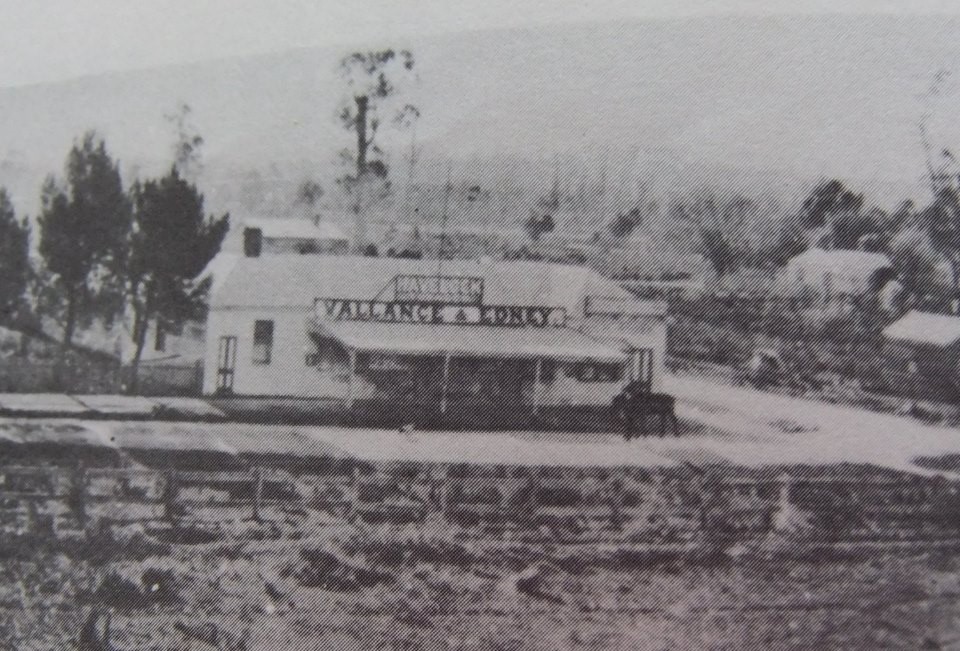
The corner of Mackey St. and Drouin Road. Fraser’s line was to the immediate right of the store and Collins’ steel line was over the road on the right. Photo Courtesy M.J. McCarthy Collection
Despite Collins’ refusals the Courts decreed that he would have to pay rental.
However the obstinate Collins decided otherwise and in a move that could best be described as cutting off your nose to spite your face, he closed the mill for three months thus putting off all his workers and leaving the State for the gold fields in Western Australia. On his return he reopened his mill but still was not going to pay Jeffers or the Fraser Estate one penny of rent in the future, so he started constructing his own line, much of which was steel, right beside the Fraser line on the same Government easement.
One Charlie Eacott drove the first tram on this new line in June 1896 to much fanfare and celebrations with colourful bunting, all of which pleased the good citizens of Longwarry. Reports are that even The Longwarry Light Infantry played a rousing rendition of the National Anthem
As one last blow to Jeffers and other Longwarry business men, Collins opened his own general store out at his mill, which considerably impacted the income of the goodly store holders in the Town.
Despite the depression of the 1890’s Collins was able to fare reasonably well, with earlier contracts to supply timber for the railways keeping his mills running.
It was a huge bushfire in 1898 that burnt the bush from Longwarry to Warburton which severely hit the Collins mill. Three kilometres of tramline were lost, along with 15 bridges, the biggest on the Gentle Annie line; it spanned 34 metres and was 8 metres high.
Despite his nature it would appear that Collins was not oblivious to the needs of his workers living in the bush camp.
The tram that carted timber into Longwarry twice a day was also made available to the camp families on special occasions and on Saturday afternoons to take them into the town, returning on Sunday evenings ready for work on Monday morning, sore heads and all from a weekend in town, no doubt at Kennedy’s hotel for a good portion of the weekend.
He also provided premises for the establishment of a school at the mill in 1891 for 17 children. The school was known as Jindivick North State School and operated part time with the Labertouche School 7 kilometres away. This joint part time schooling was not uncommon as you will see in the stories on education that will come in another chapter of the District; it was also the way of schools. In Longwarry itself the school up until 1885 operated part time with the railway construction Camp School at the Rock Cutting School.
In a similar way as Donald Fraser, William Collins had suffered from poor health for some time and after the cost incurred from the fires, low timber prices after 1900 as Australia, now a Federation, was coming out of a severe depression, he decided to auction off all his assets in 1903 at Kennedy’s Hotel in Longwarry.
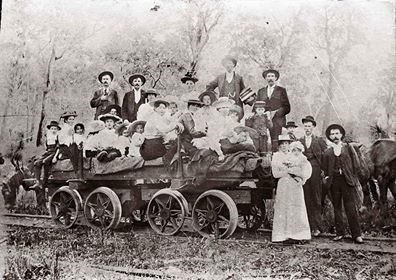
Off to Longwarry on the tram from Collins’ Mill
Note the tram wheels and tracks. Photo Courtesy M.J. McCarthy Collection
Local shop keeper Tom Maisey bought the business and so closes the first chapter of the thriving District industry of timber as a new chapter opens which we will report on at some future time.
William Henry (Harry) Collins died on December 6th. 1906, aged just 59.
Other early pioneers of the district working with timber have names that are well known, and many descendants still live all over the district. Names such as Maisey, Freeman, Eacott, Gardiner, Dore, Blackburn, Gordon, Podmore, Proposch, Ford and Hickford, just to name a few, were all workers in the early years of the timber industry in Longwarry. We will continue the story of timber into the 1930’s in the next chapter.
In researching these stories The Longwarry & District History Group gratefully acknowledge the following Resources and people:
- Level Crossing – Fraser Siding Longwarry – Longwarry Centenary Committee 1978 (esp. C. McDermid)
- John Wells – Colourful Tales Of Old Gippsland – 1984
– More Colourful Tales Of Old Gippsland – 1984
– Gippsland People, A Place And Their Past – 1986
- Settlers and Sawmillers by Mike McCarthy – 1993
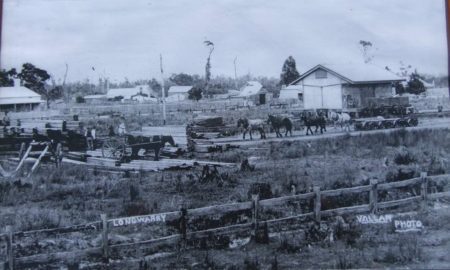
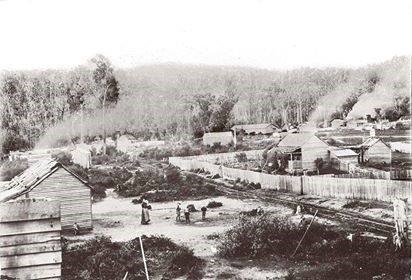
Comments